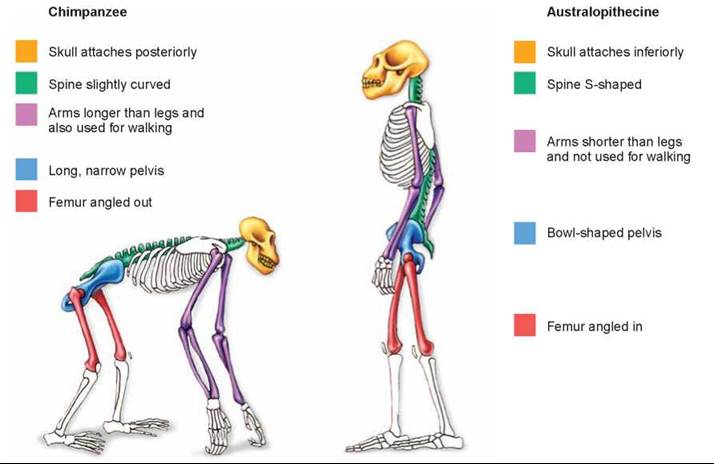THE LIVING WORLD
Unit Five. Evolution of Animal Life
21. How Humans Evolved
21.2. How the Apes Evolved
Hominoids evolved from anthropoid ancestors. Hominoids include the apes and the hominids (humans and their direct ancestors). The living apes consist of the gibbons (Hylobates), orangutans (Pongo), gorillas (genus Gorilla), and chimpanzees (Pan). Apes have larger brains than monkeys, and they lack tails. With the exception of the gibbon, which is small, all living apes are larger than any monkey. Apes exhibit the most adaptable behavior of any mammal except human beings. Once widespread in Africa and Asia, apes are rare today, living in relatively small areas. No apes ever occurred in North or South America.
Which Ape Is Our Closest Relative?
Studies of ape DNA have explained a great deal about how the living apes evolved. The Asian apes evolved first. The line of apes leading to gibbons diverged from other apes about 15 million years ago, whereas orangutans split off about 10 million years ago. Neither are closely related to humans.
The African apes evolved more recently, between 6 and 10 million years ago. These apes are the closest living relatives to humans. Chimpanzees are more closely related to humans than gorillas are; chimpanzees diverged from the ape line less than 6 million years ago. Because this split was so recent, the genes of humans and chimpanzees have not had time to evolve many differences—humans and chimpanzees share 98.6% of their nuclear DNA, a level of genetic similarity normally found between sibling species of the same genus! Gorilla DNA differs from human DNA by about 2.3%. This somewhat greater genetic difference reflects the greater time since the gorilla lineage evolved, around 8 million years ago.
Comparing Apes to Hominids
The common ancestor of apes and hominids is thought to have been an arboreal climber. Much of the subsequent evolution of the hominoids reflected different approaches to locomotion. Hominids became bipedal, walking upright, while the apes evolved knuckle-walking, supporting their weight on the back sides of their fingers (monkeys, by contrast, use the palms of their hands).
Humans depart from apes in several areas of anatomy related to bipedal locomotion. Because humans walk on two legs, their vertebral column (the bones highlighted in green in figure 21.2) is more curved than an ape’s, and the human spinal cord exits from the bottom rather than the back of the skull (see where the green vertebral column joins to the yellow skull). The human pelvis (in blue) has become broader and more bowl-shaped, with the bones curving forward to center the weight of the body over the legs. The hip, knee, and foot (in which the human big toe no longer splays sideways) have all changed proportions.

Figure 21.2. A comparison of ape and hominid skeletons.
Early humans, such as australopithecines, were able to walk upright because their arms were shorter, their spinal cord exited from the bottom of the skull, their pelvis was bowlshaped and centered the body weight over the legs, and their femurs angled inward, directly below the body, to carry its weight.
Being bipedal, humans carry much of the body’s weight on the lower limbs, which constitute 32% to 38% of the body’s weight and are longer than the upper limbs; human upper limbs do not bear the body’s weight and make up only 7% to 9% of human body weight. African apes walk on all fours, with the upper and lower limbs both bearing the body’s weight; in gorillas, the longer upper limbs (in purple) account for 14% to 16% of body weight, the somewhat shorter lower limbs for about 18%.
Key Learning Outcome 21.2. Apes and hominids arose from anthropoid ancestors. Among living apes, chimpanzees are the most closely related to humans.